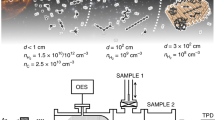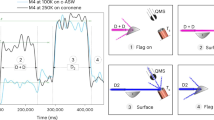Abstract
MANY attempts have been made recently to match the wavelength dependence of the observed interstellar extinction curves with calculations for theoretical models. These attempts (reviewed in refs. 1 and 2) have met with varying degrees of partial success. It is now generally recognized that a pure dielectric particle will not be able to explain the entire wavelength range of the extinction observations. In particular the very strictly linear portion (0.8µ−1 < λ−1 < 2.3µ−1) of the mean extinction curves of Nandy3,4 and the continued increase in extinction towards the far ultraviolet5 would seem to rule out homogeneous dielectric particles as a significant constituent of interstellar material. Calculations by Stecher and Donn6 and by ourselves7 have indicated that a size-distribution of pure graphite particles could produce general agreement with observations in the visible and ultraviolet spectral regions up to ∼ 2200 Å, but no agreement is possible further in the ultraviolet. This agreement includes the reproduction of an apparent hump in the observed extinction at ∼ 2400 Å—which Stecher and Donn have referred to as the “signature of graphite”. Of the grain models so far proposed the graphite core–dice mantle grain seems most favourable in being able to reproduce the detailed extinction curves in the visible spectral region as well as the overall features of the extinction up to ∼ 1500 Å (ref. 8). For such particles, however, the hump in the extinction at ∼ 2400 Å characteristic of graphite is washed out because of the effect of the outer ice mantle. If the structure in the extinction curve at the same wavelength is confirmed by future observations, the graphite core–ice mantle grain cannot be regarded as an entirely satisfactory model. A graphite component of the grains is, however, strongly indicated both by this ultraviolet feature as well as by the kink at λ−1 = 2.3µ−1 of the visible extinction observations, the latter being probably associated with a change in the refractive index of graphite. It is therefore interesting to explore the possibility that a graphite core with a dielectric mantle of refractive index different from that of ice may produce better agreement with the observations.
This is a preview of subscription content, access via your institution
Access options
Subscribe to this journal
Receive 51 print issues and online access
$199.00 per year
only $3.90 per issue
Buy this article
- Purchase on Springer Link
- Instant access to full article PDF
Prices may be subject to local taxes which are calculated during checkout
Similar content being viewed by others
References
Wickramasinghe, N. C., Interstellar Grains (Chapman and Hall, 1967).
Lynds, B. T., and Wickramasinghe, N. C., Ann. Rev. Astron. Astrophys. (in the press).
Nandy, K., Publ. Roy. Obs. Edin., 3, 142 (1964).
Nandy, K., Publ. Roy. Obs. Edin., 5, 13 (1965).
Stecher, T. P., Astrophys. J., 142, 1683 (1965).
Stecher, T. P., and Donn, B., Astrophys. J., 142, 1681 (1965).
Nandy, K., and Wickramasinghe, N. C., Pub. Roy. Obs. Edin., 5, 29 (1965).
Wickramasinghe, N. C., and Krishma Swamy, K. S., Nature, 213, 895 (1967).
Wickramasinghe, N. C., and Reddish, V. C., Nature, 218, 661 (1968).
Hoyle, F., Wickramasinghe, N. C., and Reddish, V. C., Nature, 218, 1124 (1968).
Kerr, F. J., and Garzoli, S., Astrophys. J., 152, 51 (1968).
Corrnecini, R. J., in Pure and Applied Cryogenics, 5 (Pergamon Press, 1966).
Johnson, H. L., Stars and Stellar Systems, 7, 167 (1968).
Author information
Authors and Affiliations
Rights and permissions
About this article
Cite this article
WICKRAMASINGHE, N., NANDY, K. Extinction Curves for Graphite Particles coated with Solid Hydrogen. Nature 219, 1347–1348 (1968). https://doi.org/10.1038/2191347a0
Received:
Revised:
Issue Date:
DOI: https://doi.org/10.1038/2191347a0
This article is cited by
-
The case for life as a cosmic phenomenon
Nature (1986)
-
On the optical properties of bacterial grains, I
Astrophysics and Space Science (1983)
-
A model for interstellar extinction
Astrophysics and Space Science (1982)
-
Profiles of the diffuse interstellar lines
Astrophysics and Space Science (1972)
-
Interstellar Dust and Diamonds
Nature (1969)
Comments
By submitting a comment you agree to abide by our Terms and Community Guidelines. If you find something abusive or that does not comply with our terms or guidelines please flag it as inappropriate.



